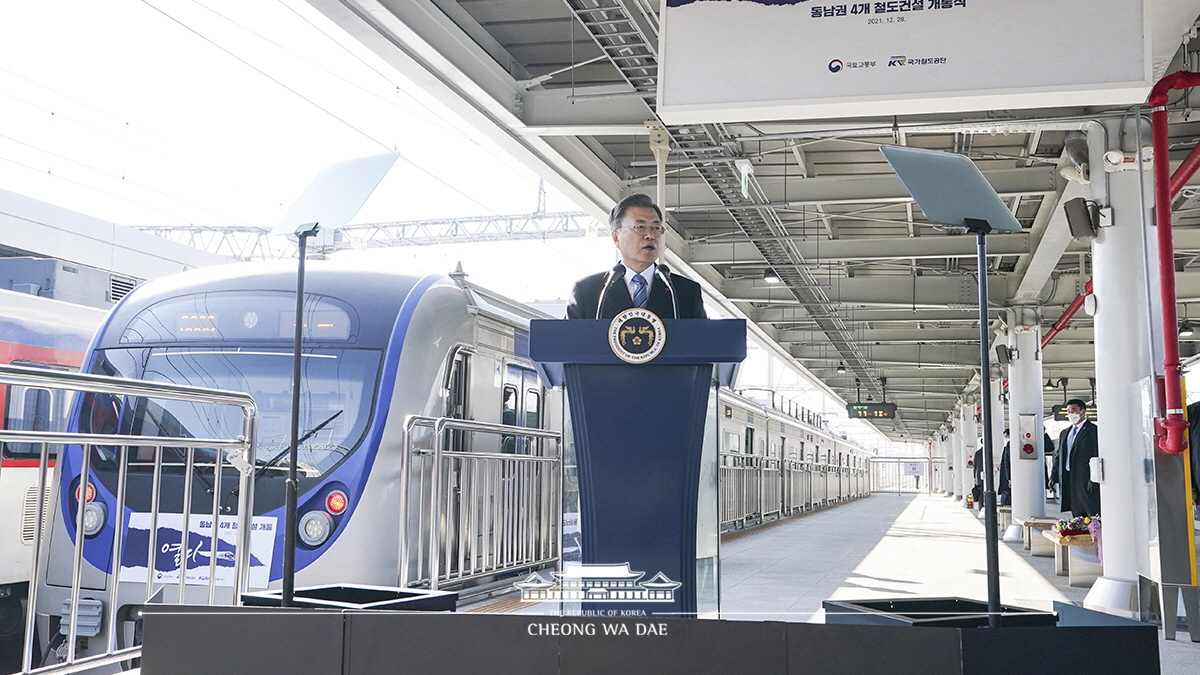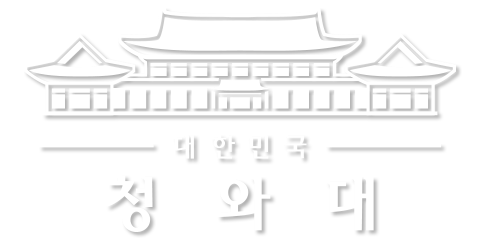이 웹사이트는 제19대 대통령 임기 종료에 따라 대통령기록관이 「대통령기록물 관리에 관한 법률」에 의해 이관받아 서비스하는 대통령기록물입니다. 자료의 열람만 가능하며 수정 · 추가 · 삭제는 불가능합니다.
다만, 「개인정보보호법」에 의하여 개인의 정보를 보호받기 원하시는 분은 관련 내용(요청자, 요청내용, 연락처, 글위치)을 대통령 웹기록물 담당자(044-211-2253)에게 요청해 주시면 신속히 검토하여 조치해 드리겠습니다. 감사합니다.
SPEECHES & REMARKS
BRIEFINGS
Remarks by President Moon Jae-in at Opening of Four Interurban Railroads in Korea’s Southeastern Region

Fellow Koreans, citizens of Ulsan, Busan and Daegu, residents of Gyeongsangbuk-do Province,
To wrap up my visits to economic policy-related locations this year, I have come to Taehwagang Station in Ulsan.
By opening four railroads in Korea’s southeastern region today, Taehwagang Station will link Wonju Station up north and Bujeon Station down south via a single train line. In January, I visited Wonju Station as my first official tour of the New Year for the opening of the the Wonju-Jecheon electrified KTX-Eum double-track line. The linking of the two regions by railroads connects this year’s initial and final tours to each other.
The opening of these four southeastern railroads makes it possible to start using the 142km-long electrified double-track line that links Daegu, Gyeongju, Ulsan and Busan. It will enable fast and convenient commutes and interurban travel and will contribute to dramatic increases in freight shipments. I am grateful to Busan Mayor Park Heong-joon, Daegu Mayor Kwon Young-jin, Ulsan Mayor Song Chul-ho and Gyeongsangbuk-do Governor Lee Cheol-woo for joining forces to open these railroads. I also commend Korea National Railway and KORAIL executives and staff for their hard work.
Citizens and residents of the Southeast Region,
This region has great potential to grow into a megacity. It is equipped with ubiquitous logistics platforms that use railroads, ports and airports. Automobiles, shipbuilding, shipping, steel making and other relevant industries form a network that makes pan-regional cooperation possible. If the Southeast is linked as a single economic sphere through transportation networks, it will become a megacity with a population of 10 million and a 490 trillion won economy. The Southeast’s railroads offer the first step toward becoming a megacity.
Beginning today, interurban electric trains will operate on the Ulsan-Busan Line, the first outside the Seoul metropolitan area. This comes 47 years – nearly a full half century – after the interurban subway system opened in the greater Seoul area in 1974.
Now, Busan’s Ilgwang and Bujeon stations can be reached in 37 minutes and 76 minutes, respectively, from Taehwagang Station. The interurban trains shuttling 100 times a day between the two cities will change the local residents’ daily lives and economic activities. The two cities will be connected into a single living zone where commuting is possible via public transportation. If the Bujeon-Masan section opens in 2023 and construction of the Southeast’s new circle and Busan-Yangsan-Ulsan lines are completed, this region will become a pan-regional, one-hour life zone. On top of this, if the new airport on Gadeokdo Island goes into operation in 2029, the region will develop into one of Northeast Asia’s top eight megacities.
The Southeast’s railroad network will link the region to others, thereby further expanding the foundation for regional growth. If the Dodam-Yeongcheon section of the Jungang Line is completed in three years, the southeastern railroad network will serve as the KTX’s second Gyeongbu Line. Busan’s Bujeon Station will be on a line that runs to Seoul’s Cheongnyangni Station, and thus, the travel time between the two stations will be reduced to 2 hours and 50 minutes. Consequently, more active exchanges with the Seoul metropolitan area will occur, and the local economies will be reinvigorated – also contributing to balanced national development.
If we dream even bigger, the Southeast’s railroad network will be the starting point of connections to trans-continental railroads in the future. If the Donghae Jungbu Line and the Donghae Bukbu Line open in 2023 and 2027, respectively, it will complete the Donghae Line that starts from Busan’s Bujeon Station. On top of this, if the railroads between the two Koreas are reconnected and linked to trans-continental railroads, the Southeast will emerge as a hub for our advance into Eurasia. This will bring about a tremendous economic effect from lowering the logistics costs: The transport time from Busan to the Netherlands will be reduced to 37 days from 60 via maritime shipping routes, and freight charges will fall by nearly half.
Fellow Koreans, citizens and residents of the Southeast,
The key to the innovative, inclusive state we envision lies in balanced national development. In addition to our balanced national development strategy and vision, the Government is pushing the Regionally Balanced New Deal – an important pillar of the Korean New Deal. Pan-regional cooperation is a more in-depth policy for balanced development. The goal is to reverse the trend of concentrations arising in the Seoul metropolitan area and form multipolar national growth hubs through ties and cooperation among provincial and municipal governments.
Busan, Ulsan and Gyeongsangnam-do will launch their special-purpose local government in the first quarter of next year. When local governments set up such entities for pan-regional cooperation, the Government will cover the initial costs for establishment and delegate as many administrative tasks to them as possible. Moreover, we will actively support pan-regional cooperation projects led by special-purpose local governments. The Government will help the pan-regional success model take root as soon as possible by revising the Special Act on Balanced National Development and the Framework Act on the National Land in the beginning of next year.
The success of pan-regional cooperation depends on intra- and interurban transportation networks. In particular – by connecting different regions – punctual, safe railroads capable of mass transport play a key role in forming a base for balanced development and creating an area where people can leave home, go about their business and return within a single day.
The expansion of the high-speed rail network will also greatly contribute to achieving our carbon neutrality goal. The KTX-Eum is a low-carbon, eco-friendly transportation means that gives off only 15 percent of the greenhouse gas emissions of passenger cars and 70 percent of those from diesel locomotives. It also runs on 79 percent of the electricity needed to operate existing KTX trains.
The Government will continue to build intra- and interurban railroad networks. Following the opening of these four railroads in the Southeast, two interurban railroad projects will be carried out in Busan, Ulsan and Gyeongsangnam-do and three in Daegu and Gyeongsangbuk-do. Along with the country’s southeastern region, six similar railroad projects will be implemented around Daejeon, Sejong and the Chungcheong provinces; Gwangju and Jeolla provinces; and Gangwon-do Province. A total budget of 12 trillion won will be injected into these projects to actively create the foundation for pan-regional cooperation.
Fellow Koreans,
Taehwagang Station has a 100-year history. In 1921, with the opening of the railroad connecting Ulsan, Gyeongju and Daegu, it started operating under the name Ulsan Station. In 2010, that name was handed over to the current Ulsan Station, but it was reborn as one of Ulsan’s iconic stations after it was rebuilt in the shape of a gray whale last March. The railroad that embarked on a new journey today from Taehwagang Station will spearhead pan-regional cooperation and bring the Republic of Korea’s vision of balanced development forward.
We support citizens of Daegu, Busan, Ulsan and residents of Gyeongsangbuk-do taking on a challenge. I hope that the Southeast’s advancement will become a new driving force for the Republic of Korea and a strong departure signal to usher in the era of Northeast Asia.
Thank you.



